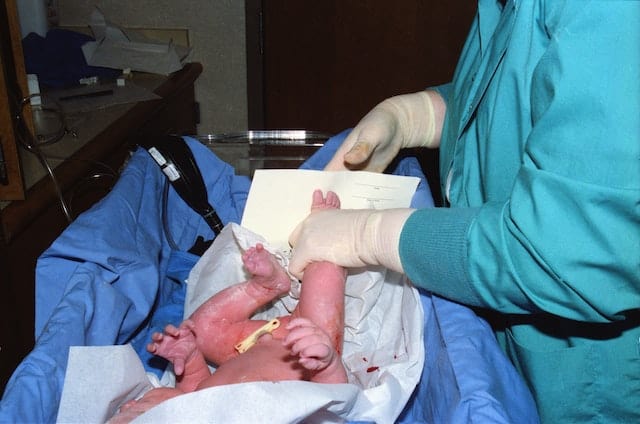Expectant mothers often wonder about the intricacies of labor, including whether it can begin while they’re sound asleep. As labor is a natural process, it can occur at any time of day or night.
As such, it is quite possible for labor to start while a pregnant woman is asleep, leading to an eventful awakening.
Understanding the signs of labor is crucial for expectant mothers, as it can help them determine if labor is initiating, progressing, and whether it requires immediate medical attention. Contractions, regardless of whether the mother is awake or asleep, can indeed be a sign of labor beginning.
However, experiencing contractions during sleep could also be the result of normal pregnancy-related discomfort or simply part of the body’s preparation for actual labor.
Key Takeaways
- Labor can begin during sleep as it is a natural process that can occur any time
- Recognizing the signs of labor is essential for determining its progress and need for medical attention
- Contractions during sleep might be indicative of labor starting, but they could also represent normal pregnancy discomfort or preparation for the main event
Understanding Labor

Labor is a complex physiological process that marks the end of pregnancy and leads to the birth of a baby. It can be divided into two main stages: early labor and active labor. Early labor is characterized by mild contractions that gradually increase in frequency and intensity.
Active labor, on the other hand, is marked by stronger contractions and significant cervical dilation, progressing towards the delivery of the baby.
During labor, contractions play a crucial role in the process of preparing the body for childbirth. These contractions are the tightening and relaxing of the uterine muscles, which help to thin out and dilate the cervix. Cervical dilation is essential for the baby to pass through the birth canal.
In early labor, the cervix dilates gradually to about 3-4 centimeters, while active labor requires further dilation up to 10 centimeters for the baby to be born.
The onset of labor is regulated by a complex interplay of hormones, with oxytocin being the key player. Oxytocin is responsible for initiating and controlling the contractions of the uterus during labor. Other hormones, such as prostaglandins, also contribute to the process by softening the cervix and promoting its dilation.
There is no specific time when labor begins, and it can start at any moment, even while the mother-to-be is asleep. It is possible for contractions to begin during sleep, as the body continues to produce the necessary hormones that trigger labor.
However, most women will wake up from the discomfort and intensity of contractions in active labor.
In conclusion, understanding labor is essential to comprehend its mechanics and physiological changes that occur during the process. The various stages of labor, aided by contractions and hormonal regulation, prepare the body for the birthing experience.
While labor can start at any time, the intensity of contractions typically wakes women up from sleep during active labor.
Signs of Labor
When a pregnant woman is nearing the end of her pregnancy, it is important to be aware of the signs of labor. These signs can indicate that labor is imminent or has begun. It’s possible for labor to start while sleeping, so recognizing these signs can help prepare her for the birth process.
Braxton Hicks contractions are often mistaken for real labor contractions. They are irregular, infrequent, and generally painless. These contractions can help prepare the body for labor, but they do not signify its onset.
Real contractions, on the other hand, are a sign that labor has begun. These contractions are regular, consistent, and grow closer together over time. They usually increase in strength and frequency, and do not dissipate with movement or change in position.
Another sign of labor is back pain that radiates from the lower back to the abdomen. This pain is often accompanied by cramping sensations similar to menstrual cramps. While these symptoms may be uncomfortable, they signal that the body is getting ready to give birth.
During labor, the mucus plug that seals the cervix throughout pregnancy may be expelled. This is known as the bloody show and can be accompanied by a small amount of bleeding. This is a good indication that the cervix is beginning to efface, or thin and open, in preparation for delivery.
Some other signs and symptoms of labor to be aware of include an increase in the urgency or frequency of urination, diarrhea, and nesting behavior, which is a sudden urge to clean or organize the home in anticipation of the baby’s arrival.
In conclusion, it is essential for pregnant women and their support team to be familiar with these signs of labor. Early recognition can help ensure a smooth and safe birth experience.
Sleep and Pregnancy
Adequate sleep is essential for good health, and this is particularly true during pregnancy. Pregnant individuals often experience changes in their sleep patterns due to hormonal fluctuations, leading to increased fatigue and difficulty falling or staying asleep.
Maintaining a regular sleep schedule and creating a comfortable sleep environment can help alleviate some of the challenges associated with sleeping during pregnancy.
Stress can also have an impact on sleep quality. Pregnant individuals may experience heightened levels of anxiety and worry about their baby’s health, childbirth, and various other aspects of pregnancy. Practicing relaxation techniques, such as deep breathing or meditation, can help reduce stress and improve sleep quality.
Additionally, regular exercise and maintaining a balanced diet contribute to better sleep and overall health during pregnancy.
It is a common concern whether labor can begin while sleeping. The body undergoes various changes to prepare for childbirth, and some of these changes may be experienced while asleep. For example, contractions can occur during sleep, which may be an early sign of labor.
Pregnant individuals should familiarize themselves with the signs of labor and communicate with their healthcare provider to better understand when labor is imminent.
Sleeping positions can also play a role in inducing labor. It is generally recommended to sleep on the left side during pregnancy, as this position promotes optimal blood flow to the fetus. Although other positions may not be as ideal, it is important to ensure comfort during sleep.
A pregnant individual should listen to their body’s signals and consult their healthcare provider for recommendations on the best sleep positions during the various stages of pregnancy.
In summary, sleep plays a crucial role in pregnancy, and adopting healthy sleep habits can contribute to a smoother pregnancy experience. Understanding the common changes in sleep patterns, managing stress, and being aware of the signs of labor can help pregnant individuals navigate this unique period in their lives with greater ease and confidence.
Can Labor Start While Sleeping

It is entirely possible for labor to start while a person is sleeping. The body undergoes various changes and processes during pregnancy, preparing itself for the impending delivery.
Contractions, which are the primary signs of labor, can occur at any time of the day or night, regardless of whether the person is awake or asleep.
During the early stages of labor, contractions may be mild and irregular, which could potentially go unnoticed during sleep. As labor progresses, these contractions become more intense and regular.
In many cases, the increasing intensity and frequency of contractions eventually wake the person up, alerting them to the fact that labor has begun.
There are a few factors that indicate labor may be more likely to start during sleep:
- Hormonal changes: The body releases higher levels of oxytocin, a hormone responsible for inducing contractions, during sleep. This increase could trigger the onset of labor while a person is sleeping.
- Relaxed muscles: A person’s muscles are more relaxed during sleep, which might allow the body to progress into labor more easily.
- Circadian rhythms: The body’s natural sleep-wake cycle, or circadian rhythm, might play a role in the onset of labor. Some studies have indicated a correlation between nighttime hours and the initiation of labor.
It is important to point out that labor is a complex process involving multiple physiological variables, and the exact timing will vary from one individual to another. Although labor can and does start while sleeping for some people, the experience may be different for others.
Every pregnancy is unique, and it is crucial to be aware of one’s body and contact their healthcare provider if they suspect labor has begun or if they have any concerns regarding their pregnancy.
Water Breaking and Amniotic Fluid
Water breaking is a common term used to describe the rupture of the amniotic sac, which contains amniotic fluid. This fluid serves as a protective cushion for the baby throughout the pregnancy.
When the amniotic sac breaks, it releases the amniotic fluid and signals that labor might be starting soon. It is possible for this to happen while a pregnant person is asleep.
The amniotic sac is a thin membrane that surrounds and protects the baby during pregnancy. It is filled with amniotic fluid, which helps regulate the baby’s temperature, provides nutrients, and cushions them from potential injury.
Amniotic fluid also allows the baby to move within the womb, helping to promote healthy bone and muscle development.
When the amniotic sac ruptures, it can result in a sudden gush of fluid or a slow leak. The amount and manner in which the fluid is released can vary greatly among individuals. In some cases, it can be challenging to determine if the fluid is amniotic fluid or simply urine.
If there is any doubt, the pregnant person should contact their healthcare provider to assess the situation.
Labor can begin at any time once the water has broken. However, it is important to note that several factors can influence the onset of labor. Sometimes, labor might not start immediately after water breaking.
In such cases, healthcare providers may intervene to induce labor for the safety of the baby and pregnant person. On the other hand, some individuals may not experience water breaking until they are well into labor, or it may happen under the guidance of a healthcare provider during labor.
In summary, water breaking and the release of amniotic fluid can happen while a pregnant person is sleeping, signaling the onset of labor. It is essential to monitor for any possible signs and reach out to a healthcare provider if there is any doubt about the situation.
Preparing for Delivery

When the due date is approaching, it’s essential for expecting mothers to be well-prepared for the arrival of their baby. There are several key steps that can be taken to ensure a smooth delivery process and to provide peace of mind throughout this exciting time.
First, it is important to choose the right healthcare provider and delivery location. This may include a hospital, a birthing center, or a home birth attended by a midwife.
Be sure to research your options and consider factors such as the staff’s experience, a facility’s available resources, and your own personal preferences.
Next, create a birth plan with the help of your healthcare provider. This should include decisions on pain management methods, whether you prefer a vaginal delivery or a cesarean section, and any specific needs or requests during labor.
Remember, while having a plan is helpful, it is also important to remain flexible, as circumstances may change during the delivery process.
As the expecting mother gets closer to the due date, it is essential to have a hospital bag prepared. This should contain items such as comfortable clothes, toiletries, important documents, and any essentials for the baby, like diapers and clothing.
Discuss with your healthcare provider any additional items that may be necessary for your specific situation.
Lastly, familiarize yourself with the various stages of labor and what to expect during each phase. This knowledge can help alleviate some of the anxiety and uncertainty that may arise during the delivery process.
Additionally, consider attending a childbirth class, where you’ll learn valuable information on pain management techniques, breathing exercises, and more.
By following these steps, expecting mothers can feel confident and well-prepared for their baby’s imminent arrival. A carefully planned and well-informed approach will not only reduce stress but also contribute to a smoother, more positive delivery experience for both mother and baby.
Special Cases: Preterm and False Labor
Preterm labor occurs when contractions begin early, specifically before 37 weeks of pregnancy. These contractions may cause cervical changes like dilation and effacement, potentially leading to a premature birth.
It is essential to recognize the signs of preterm labor, as early intervention can help prevent complications for both the mother and baby. Such signs include regular contractions, lower back pain, and pelvic pressure.
In some cases, labor can indeed start while a pregnant individual is sleeping. Just like daytime labor, sleeping individuals experiencing preterm labor may be awakened by the contractions and other associated sensations.
It is crucial to seek medical attention immediately if preterm labor is suspected, as a healthcare professional can provide appropriate treatment and guidance to manage the situation.
False labor, also known as Braxton Hicks contractions, can occur at any time during pregnancy, including while sleeping. These contractions are irregular, infrequent, and usually painless, and they do not lead to cervical changes.
A key difference between false labor and real labor contractions is their level of predictability and duration. False labor contractions are generally inconsistent in duration and interval, while real labor contractions follow a more regular pattern and increase in intensity over time.
If one experiences contractions while sleeping but is unsure about whether they signify preterm labor, false labor, or real labor, it is important to track the contractions and their frequency.
Keep in mind the main differences between real and false labor contractions to distinguish between them properly. Nonetheless, when in doubt, it is always advisable to consult a healthcare professional for guidance and clarification.
Frequently Asked Questions
Can contractions occur during sleep?
Yes, contractions can occur during sleep. In fact, many women experience contractions throughout the night in the weeks leading up to labor. These contractions might be more noticeable while sleeping due to the body’s relaxed state.
Some contractions experienced at night are known as Braxton Hicks contractions, which are often mistaken for real labor contractions but are actually a normal part of pregnancy.
How does sleep affect the onset of labor?
Sleep can affect the onset of labor indirectly. Adequate sleep is vital for overall health and well-being, including the proper functioning of hormones involved in labor. Lack of sleep might contribute to stress, which can potentially affect labor progression.
However, there is no direct cause-and-effect relationship between sleep patterns and the onset of labor.
Is it possible to miss labor signs while asleep?
While it is possible to sleep through mild contractions or other early labor signs, most women become aware of labor as it progresses. The intensity of contractions tends to increase over time, making it unlikely that a woman will be able to sleep through active labor.
However, if you’re concerned about missing labor signs while asleep, speaking with your healthcare provider can help ease your worries and provide guidance on what to watch for.
Can labor progress be impacted by sleep?
Sleep might influence labor progression indirectly. Being well-rested can help expectant mothers cope better with the physical and emotional demands of labor.
On the other hand, exhaustion can contribute to a more challenging labor experience and hinder coping mechanisms, such as relaxation techniques or focused breathing. Ultimately, each individual’s labor experience will be unique, and a variety of factors will influence its progression.
Some sleep-related indications of approaching labor include an increase in vivid dreams, a restless feeling, or difficulty finding a comfortable sleeping position. These experiences could be related to hormonal changes, increased anxiety, or physical discomfort as the body prepares for labor.
Many women also report a burst of energy, known as nesting, in the days leading up to labor. This might lead to difficulty falling or staying asleep.
Do sleeping positions influence the beginning of labor?
Currently, there is no conclusive evidence suggesting that specific sleeping positions directly influence the beginning of labor. However, certain sleeping positions can provide comfort to expectant mothers during the later stages of pregnancy.
For example, sleeping on the left side can improve circulation to the baby and alleviate pressure on the mother’s back. Ultimately, it is essential to find a comfortable position that helps promote quality sleep and overall well-being during pregnancy.

Iesha is a loving mother of 2 beautiful children. She’s an active parent who enjoys indoor and outdoor adventures with her family. Her mission is to share practical and realistic parenting advice to help the parenting community becoming stronger.
